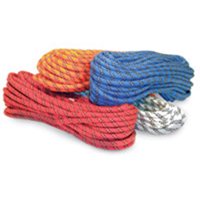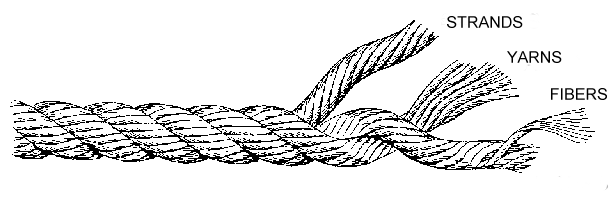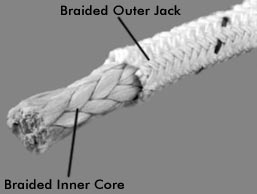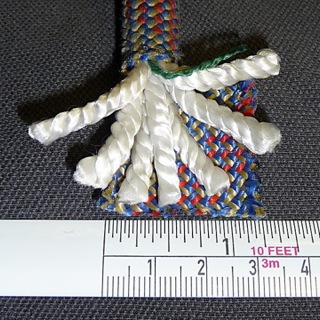Ropes and Knots

Rope and Knots
Rope is an important piece of SAR equipment. It can be used to secure SAR personnel in dangerous terrain, to assist with the transport of a victim, an much more. Knowing the type of rope to use in any specific rescue situation is critical. It is important to start out by discussing how rope is constructed.
To skip rope construction and move on to tying knots
Click Here.
Rope Construction
The most common materials used in manufacturing ropes used for climbing and rescue are polyester and nylon. These materials do not rot, are easily inspected by wear, and have a high strength-to-weight ratio.
The type of construction is critical to emergency services use. The three main types of rope construction used are: laid, braided, and kernmantle. Of these, kernmantle is the most common in rescue rope.
Laid Rope
Laid Rope is many small strands of twisted fibers that are combined with other strands to form the diameter of the rope. At one time, laid rope was most commonly used for climbing and caving, unfortunately laid rope tends to untwist when loaded with weight making it unsuitable to use as a "lifeline".

Laid Rope Construction

Braided Rope
Braided Ropes are woven by overlapping multiple strands of fibers. These ropes stretch a great deal and are not recommended for emergency use or as a lifeline. Braided ropes are commonly found in most hardware stores.
Kernmantle Rope
Kernmantle ropes are constructed using two parts, an outer sheath, and an inner core of strands. The outer sheath is a tightly woven tube that serves to support a load and protect the inner core. The inner core consists of strands of fibers bundled together to provide most of the strength of the rope. Since these ropes are strong and fairly easy to tie in knots, this type of rope construction is recommended for lifeline in rescue work.

Kernmantle - comes in two basic types, lowstretch (static) and high-stretch (dynamic), both which can be used by rescuers and emergency personnel.
Static - rope is used for rappels, lowers, traverses or crossings and other situations where there will be little or no climbing required. Static rope is not used in situations where a rescuer may fall any distance and shock-load the system.
High-Stretch - rope consists of inner strands that are twisted or braided, and allows them to elongate and stretch under load. This type of rope is used for climbing, as the stretch of the rope will act as a shock absorber during a fall. High stretch ropes are more pliable and easier to tie knots in, but generally not as strong and abrasion resistant as static rope.
NOTE
Rope rescue is a dangerous activity that requires extensive training and practice to conduct safely. Most rope used on a search and rescue mission should be low-stretch kernmantle, and SAR personnel should not be expected to perform rescues in a technical environment without rope rescue training.
Breaking Strength- is the point at which a rope fails under a load. A two person load requires a rating of 9000 pounds, or 15:1 safety factor. Some SAR agencies rely on a safety factor of 10:1 for many reasons, mostly because of weight. The 10:1 safety factor allows for lighter equipment, something worth thinking about when hiking for long distances.
Rope and Knots Tips
Caring For Your "Software"
Rope, webbing, harnesses, and other "soft" rescue equipment is referred to as software. This type of equipment must be used, monitored, and maintained carefully.
- Keep a Log - Detailed logs should be kept for each piece of equipment. Information should include it's ID marking, size, type, manufacturer, date purchases, date in service, where it was purchased and lot number.
- Care - Never step on, or drag your software. Dirt particles can work into the fibers, making invisible cuts which weakens the rope.
- Storage - Always store software out of direct sunlight. Ultraviolet radiation can weaken the fibers. Never expose your software to chemicals or petroleum vapors. Avoid acids and vapors from batteries as this will weaken synthetic materials. Store software in separate area in your pack.
Software should be inspected on a regular basis. Any equipment that shows signs of wear, or weakness should be taken out of service immediately.
In the field, K9 Handlers or SAR team members may need to tie a harness to access areas in harsh terrain. Sometimes it may be necessary to tie ropes or webbing to a liter to evacuate the subject.
Click here
for examples on a variety of knots, ties, hitches, and bends.
Return from "Ropes and Knots" to "K9 Search and Rescue Home Page"




